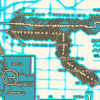Free Online Productivity Tools
i2Speak
i2Symbol
i2OCR
iTex2Img
iWeb2Print
iWeb2Shot
i2Type
iPdf2Split
iPdf2Merge
i2Bopomofo
i2Arabic
i2Style
i2Image
i2PDF
iLatex2Rtf
Sci2ools
131
Voted
Publication
Using GIS to Measure the Effect of Overlapping Service Areas on Passenger Boardings at Bus Stops
This study examines the effects of overlapping walking service areas of bus stops on the demand for bus transit. This requires controlling for variation in potential transit demand as measured by the number of dwelling units and their locations. A model of passenger boardings for the morning peak hour of service is estimated. Boardings are modeled as a function of potential transit demand at the level of the individual bus stop. To address overlapping bus stop service areas, a geographic information system is used to measure the accessibility of each parcel to each bus stop relative to other accessible stops. A distance decay function is empirically estimated and used to calculate walking accessibility from dwelling units to bus stops. This stop level boarding model is an improvement over methods in which ridership is typically related to potential transit demand using one-quarter-mile service areas under the assumption of uniform density of demand, often with little or no consideratio...
| Added | 09 Feb 2009 |
| Updated | 19 Apr 2009 |
| Type | Journal |
| Year | 2007 |
| Where | Journal of the Urban and Regional Information Systems Association |
| Authors | T. J. Kimpel, K. Dueker, A. M. El-Geneidy |
Comments (0)




